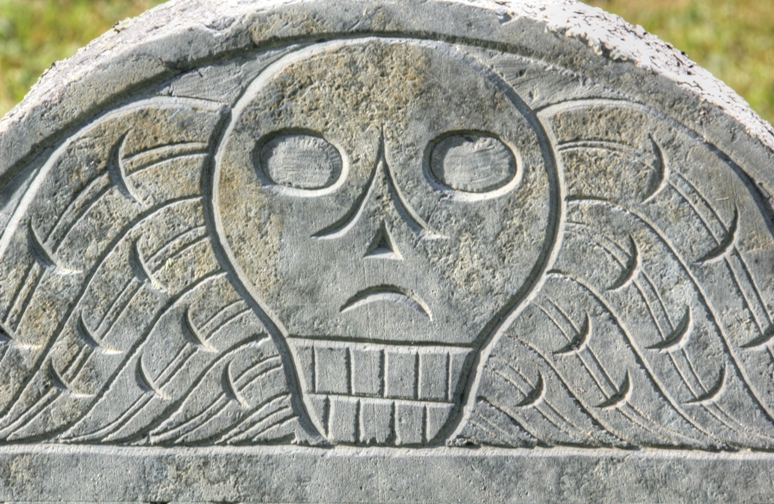
After getting hooked on cemeteries (Day 13) I’m now prone to being on the lookout for them. Living in a rural area, I don’t have to look far. Every village has at least one cemetery if not more. And, if you are lucky enough to meet Deborah Trask, you’ll learn a whole lot about gravestones.
For starters, Deborah is one of Canada’s top authorities on the subject. She loves artefacts (and their preservation) and is the author of Life how short Eternity how long: Gravestone Carving and Carvers in Nova Scotia. Deborah has a lifetime of research filed away in her head with stories that match.
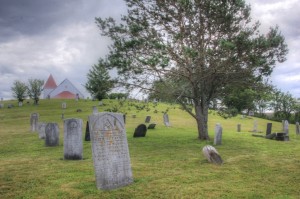 We started our tour on the hill behind what was the Hebron Baptist Church—currently a Masonic Hall. The funny thing is that I’ve passed by this cemetery a gazillion times while visiting friends who used to live on the lane that goes right and behind that cemetery … and never once noticed it.
We started our tour on the hill behind what was the Hebron Baptist Church—currently a Masonic Hall. The funny thing is that I’ve passed by this cemetery a gazillion times while visiting friends who used to live on the lane that goes right and behind that cemetery … and never once noticed it.
It’s mid morning. That’s intentional as Deborah was hoping to catch the morning light to best see the headstones. A light sprinkling of rain passed on by then the sun came out just in time, for she had brought along a full length mirror. Must admit, looks funny to see someone in a cemetery walking around with 5-ft. mirror, but let me explain.
If you place a large mirror on an angle a few feet away facing a gravestone and catch some sunlight, the whole thing will become “illuminated.” It’s downright fascinating. Photo above on the left is what the eye could normally see; photo on the right was taken while Deborah held the mirror up in front just a few feet away.
And here’s another set taken at Town Point Cemetery later that morning. On the left, Deborah has mirror turned over. To the right, she’s angling it to catch the sun which sheds a lot more light on the matter. As you can see, a mirror can provide dramatic results.
Many headstones in Nova Scotia have carved symbols—from angels to cherubim faces (both happy, sober, and sad), trumpeting figures, hands, flowers, rope, willow and urn motifs … ad infinitum. They are carved on sandstone, white stone, Vermont marble, slate, and granite. Some gravestones are surrounded by several short granite pillars that would have had a large chain surrounding a family plot or a prominent figure.
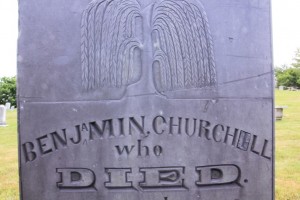 One headstone from 1849 that made me grin was signed J.T.A. (local stone carver, Joseph Tupper Archer). Note the mistakes … the A inserted Benjamin and the correction in Churchill. That would have been one major “oops.”
One headstone from 1849 that made me grin was signed J.T.A. (local stone carver, Joseph Tupper Archer). Note the mistakes … the A inserted Benjamin and the correction in Churchill. That would have been one major “oops.”
As we roam around, she points out to some damaged stones. Most are nicks and gauges caused by lawn mowers or whipper snippers. Also Deborah says that a huge amount of damage is done when well-intentioned people try to scrape moss and lichen off of old gravestones. “This causes irreparable damage and can reduce the life of a gravestone by decades” she says.
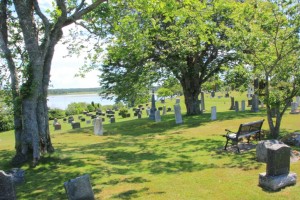 Eventually we mosey on to Town Point Cemetery in Chebogue—high on Deborah’s list of favourites. History oozes out of the ground here and the site is stunning. (Another great place for a picnic.)
Eventually we mosey on to Town Point Cemetery in Chebogue—high on Deborah’s list of favourites. History oozes out of the ground here and the site is stunning. (Another great place for a picnic.)
It’s also the place where her father, F. Stuart Trask, is buried. His headstone is a handsomely cut gray Virginia slate and simply says, “a leader always.” I think this is also an apt description of Deborah. She’s involved in many volunteer things, such as the establishment and on-going success of the Lunenburg Folk Festival for one. She also started the 1998 Cemeteries Protection Act. This is a big deal, as it outlines several “cannot” do’s in relation to burial grounds and helps us preserve our past.
I comment about being pleased to see that there are no plastic flowers at her father’s grave—adding that it’s one of my pet peeves, seeing graveyards cluttered with this fake stuff. I expected her to commiserate but, to my surprise, Deborah has a different point of view. “Some people leave plastic flowers; others leave solar lights, plastic figurines, a deck of cards … these are signs of mourning. And it’s a sign of life. A cemetery is intended to be used by the living.” I’ve chewed on that notion for awhile and can see her point. Working on letting go of my snobbishness.
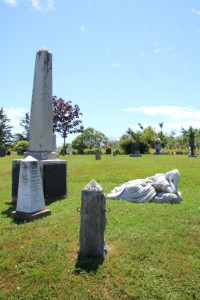 Meanwhile, I’ve always heard about “the marble lady” here at Town Point Cemetery. There have been many stories told about this lady, and rather than paraphrase what Deborah told me, I’m lifting a hunk straight from her book.
Meanwhile, I’ve always heard about “the marble lady” here at Town Point Cemetery. There have been many stories told about this lady, and rather than paraphrase what Deborah told me, I’m lifting a hunk straight from her book.
So if you are looking for the definitive version, this is it.
The Margaret McNaught Webster monument is curious because separate from the gravestone is a life-sized marble statue. This depicts the prone Margaret McNaught supposedly as Frederick A. Webster first saw her in a Scottish field, dozing on a sheath of wheat, sickle in hand. They were married in Halifax in the spring of 1834. The statue (particularly the feet) has been chipped away by perverse souvenir hunters. The separate monument which gives Mrs. Webster’s vital statistics is a granite obelisk with purple slate panels.
So there you have it.
As we were leaving, Deborah draws on a quote from the late Jane Irwin, “A place without a cemetery is a place without a memory.” I’ve been thinking a lot about this and digesting what it means.
I’m also grateful for all the volunteers who are involved in preserving our graveyards.
In some instances, like the cemetery in Hebron, it was totally run over with alders until some caring souls got together and decided to uncover and recover what they could.
Imagine that.
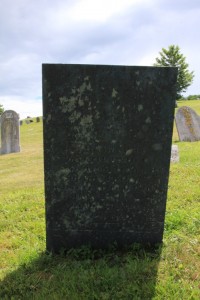
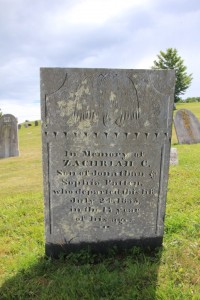
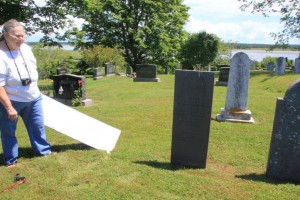
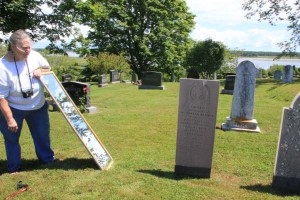

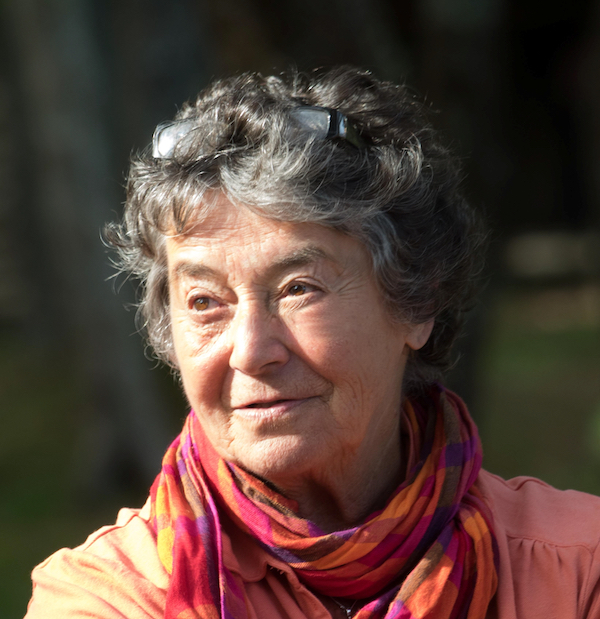
Thanks again, Sandra. I was considering removing the moss from my parents’ headtone. Is there a way to do that without
causing damage?
Hi Rose-Marie,
I most likelihood, the “moss” you’re referring to is actually not moss but lichen. The problem with getting lichen off stones is that it is a. very hard to do this without damaging the stone, and b. if you wash the entire stone, you simply spread the lichen spores around and on that nice clean surface, it’ll look good for a few years, and then you’ll notice it will be all over the stone.
Best not to disturb it – if the markings are obscured you could try with your fingernail to see if it will peel off, but I wouldn’t use anything else. Lichen comes and goes and eventually the stone may be less covered if left alone, and we certainly don’t want to do anything to harm a marker. A friend points out that even with the greatest of care, there’s always grit in a bucket after washing a stone – that grit is former stone surface! My rule of thumb – don’t do anything you can’t undo after!
Bill
Great advice Bill. I’m sure Deborah will concur with you. Just waiting to hear back from her and will post her comments as well. (PS Rose-Marie, Bill is heavily involved in a project called Old Stones in Port Maitland. It’s an amazing project. I’ll have a post about these cemeteries in a couple of days! Meanwhile, check it out at http://www.oldstones.ca
Oops, I see that I posted my reply to another person. I’ve sent Deborah an email asking if there is a safe way to clean stones. I suspect that the answer is no, but … best to ask the pros.
Rose-Marie, I heard from Deborah. She says, “There is no easy general way to clean gravestones – mostly because they are not dirty. Removal of biological growth usually damages the surface – witness the enormous damage done at Chebogue by pressure washing.” So it sounds like it’s best to leave “as is.”
Thanks for this, especially the business about removing moss. Good to know.
Let me check with Deborah about this. Will get back to you!
Deborah came to see our little cemetery. Lovely lady. Our cemetery was also covered in alders and weeds when we moved here …
Oh! That must have been wonderful to have her visit! And also wonderful that you were able to recover the cemetery on your property!
Another fascinating blog, Sandra! Deborah’s knowlege of all things graveyard-related is amazing. I was given a copy of her book years ago by some houseguests as a thank you gift. It seemed a slightly odd way to say thanks for the hospitality at the time, but once I started reading it I was so glad they’d chosen the book rather than a kitschy dust collector 🙂
Happy to hear you have Deborah’s book! The more I read, the more I find this whole topic of cemeteries and their preservation a fascinating one. But yes, it seems like an odd “thank you” gift … at first.
Another fascinating post! You reminded me of many pleasant days in my childhood spent perusing ancient gravestones in cemeteries in Kings County. A few years back on a visit to Wolfville, I found some headstones from the 1700s in the Hortonville cemetery. They have wonderful carvings. My favourite cemetery is the one in Pereaux, where many of my family members are laid to rest. I love to take people there and show them Cinderella’s grave marker! Thank you for showing the world how interesting and storied your part of the Nova Scotia is. I’m not sure about a place without cemeteries, but a place without storytellers is indeed one without memory. Or vision. Cheers!
Thanks for popping into view Shelley! If I’m ever in Pereaux, I will visit the cemetery there for sure! Will be on the lookout for Cinderella!
I had an ewww moment when I read your line “History oozes out of the ground here” as it conjured up images of, well, you know…bodily fluids of the dead. I also had a “no kidding” moment when I read the tombstone “Benjamin Churchill Died”. Then I realized that it must have continued, beyond the bottom of the photo, with the date of his death. I have always loved cemeteries though I don’t care to ever have my remains in one. I will probably have my ashes stored in a pantry in a mason jar.
Too funny Jennie. I was going to post a photo of the entire tombstone of Benjamin Churchill, but this close up half was easier to read (and see the mistakes which I think are hilarious.) And, yes, on second thought, ” …history oozing out of the ground” may not have been the best choice of words. haha
The key to using light to read weathered stones is to create a contrast, rather than fully illuminate the stone. As seen in these photos, shining light from an angle illuminates the face surface while creating shadows in the engravings.
I first saw the effectivness on the excellent candle-light tour of the ancient Garrison Cemetery in Annapolis Royal. In addiiton to setting a mood for the storyteller, touring the graveyard after dark allowed us to illuminate the stones from a single source. This revealed engravings that had been indecipherable, even invisible, when flooded with daylight.
Appreciate your comments Phil. Helps us to understand what’s going on when we use mirrors. Also interesting to know that the same effect can be achieved using candles at night! Fascinating stuff!
Phil is correct – the idea is to light the markers from an angle approaching 90 degrees to bring out the contrast and use shadow to make the engraving stand out. The mirror is a good way to do this, but I’ve also done this much more “compactly” with my dish reflector – a small pizza box sized cloth hoop with two reflective surfaces that expands when you open it to about a meter in diameter. One side is white and one side is silver, which throws light very well and really makes the markers shine.
I am also playing with 3-d modelling. I was at a cemetery conference at St. F.X. this spring presenting our information on Old Stones (and Deb and Heather Lawson were both their doing their things as well…) and I got chatting with another individual (a Ph.D.s student) who is using the same 3-d modelling software I’m playing with. Essentially, it allows the photographer to go around the face of the marker and then blend the images to bring out the engraving without even touching the stone.
Fascinating stuff Bill! Thanks for weighing in on the conversation.